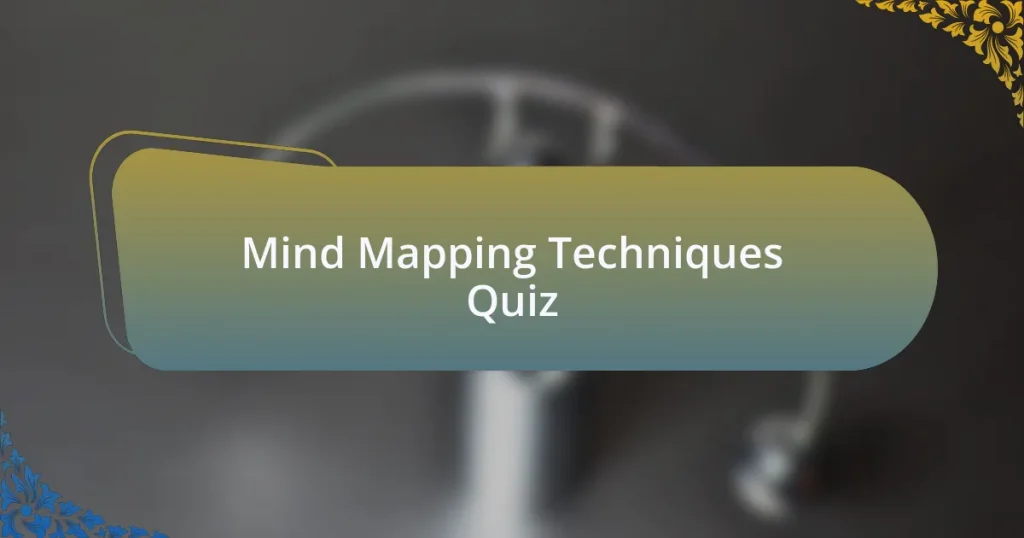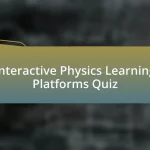Start of Mind Mapping Techniques Quiz
1. What is the primary purpose of a mind map in physics test preparation?
- To create lengthy written notes for easier revision.
- To strictly follow a linear format and avoid any creativity.
- To summarize all concepts without visual representation.
- To visually organize information into a hierarchy and enhance creativity and memory.
2. How can mind maps help in understanding complex physics concepts?
- They limit information to only written words.
- They make studying less interactive and engaging.
- They visually organize complex concepts, aiding comprehension.
- They focus solely on memorization techniques.
3. What is the significance of the central theme when creating a mind map for physics topics?
- The central theme groups unrelated topics into one.
- The central theme limits creativity and flexibility in ideas.
- The central theme is just a decoration without meaning.
- The central theme represents the main idea or topic of the mind map.
4. How can associations be effectively visualized in a physics mind map?
- Placing all information in a linear fashion without branches.
- Using multi-headed arrows of varying color, size, style, and dimensions.
- Utilizing only straight lines to connect ideas.
- Creating a mind map with no visual elements or colors.
5. What types of keywords should be included in a physics mind map?
- Single keywords or short phrases
- Long paragraphs of text
- Full sentences with explanations
- Complex equations and formulas
6. Why is color-coding beneficial in organizing physics study materials through mind mapping?
- It helps in remembering information better.
- It is used to fill empty spaces.
- It only serves as decoration.
- It makes the mind map look colorful.
7. What is the typical number of main branches in a physics mind map?
- 10
- 2
- 5
- 3
8. How do images enhance the learning experience in a physics mind map?
- Images can only distract from the main topic and confuse learners.
- Images do not have any significant impact on memory recall during learning.
- Images help illustrate ideas and make connections between different topics.
- Images are unnecessary in a mind map since text is sufficient for understanding.
9. What is the ideal way to structure subtopics in a physics mind map?
- Subtopics should be numbered in a specific order and written in paragraphs.
- Subtopics should be placed randomly around the mind map without a clear structure.
- Subtopics should be organized by branching out from the central theme and using different colors for each branch.
- Subtopics should be listed in a straight line from left to right without any color.
10. How can line thickness indicate the relationship between different physics concepts in a mind map?
- Thicker lines indicate unrelated concepts.
- All lines must be the same thickness for clarity.
- Line thickness has no effect on how concepts are connected.
- Varying line thickness can indicate the strength of connections between concepts.
11. What are the advantages of using diagrams and pictures in physics mind mapping?
- Diagrams and pictures confuse the visual learning process.
- Diagrams and pictures serve no purpose in mind mapping.
- Diagrams and pictures make understanding concepts easier.
- Diagrams and pictures make mind maps look unorganized.
12. How does hierarchical thinking support the organization of physics knowledge in mind maps?
- Hierarchical thinking only focuses on unrelated concepts, hindering comprehension.
- Hierarchical thinking organizes knowledge into structured layers, enhancing understanding and recall.
- Hierarchical thinking offers no benefits in organizing physics knowledge effectively.
- Hierarchical thinking complicates the learning process and creates confusion in concepts.
13. What is radiant thinking`s role when exploring physics concepts through mind mapping?
- Radiant thinking allows for the exploration of interconnected ideas and concepts.
- Radiant thinking focuses solely on linear progressions of thoughts.
- Radiant thinking discourages visual representation of concepts.
- Radiant thinking limits creativity by adhering to strict rules.
14. How can digital tools enhance the effectiveness of mind mapping for physics test prep?
- Digital tools restrict the ability to customize mind maps effectively.
- Digital tools allow for real-time collaboration and multimedia integration.
- Digital tools make mind maps more complex and less clear.
- Digital tools primarily serve as an alternative to traditional note taking.
15. Which digital mind mapping software is commonly used for studying physics?
- Microsoft Excel
- Google Docs
- MindMeister
- Notepad
16. Why is it essential to regularly update a mind map used for physics revision?
- It eliminates the need for studying other revision methods.
- It allows for more space to introduce irrelevant ideas.
- It ensures the information remains relevant and reflects new knowledge gained.
- It makes the mind map look more colorful and attractive.
17. How can color differentiation be used to simplify the study of various physics topics?
- Color differentiation is only for art and has no relevance in physics.
- Color differentiation confuses students, making physics harder to learn.
- Color differentiation can categorize topics, aiding retention and understanding.
- Color differentiation increases complexity without any educational benefit.
18. What is the importance of keywords in summarizing physics concepts within mind maps?
- Keywords increase the length of the mind map, confusing users and complicating recall.
- Keywords summarize information, making it easier to scan the map quickly and identify key ideas and concepts.
- Keywords complicate the mind mapping process, leading to less effective summarization.
- Keywords distract from the main ideas, making it harder to understand concepts.
19. How might images serve as mnemonic devices in a physics mind map?
- Images are only useful for artistic representation and not memory.
- Images can enhance memory and recall by making concepts more vivid.
- Images serve no purpose in a mind map and can be ignored.
- Images distract from the main ideas and create confusion.
20. What is the advantage of maintaining appropriate spacing in a physics-focused mind map?
- Proper spacing helps separate ideas, making the map easier to read and understand.
- Proper spacing restricts connections between ideas, limiting creativity.
- Proper spacing reduces the number of keywords used, simplifying the concepts.
- Proper spacing allows for unlimited topics, creating a more chaotic mind map.
21. How can borders in a mind map help in highlighting critical areas of physics study?
- Borders distract from important concepts in physics study.
- Borders are unnecessary in physics mind maps.
- Boundaries and borders highlight key study areas effectively.
- Boundaries weaken the connection between topics in mind maps.
22. What purpose do linear hierarchies serve in a physics mind map?
- Linear hierarchies help organize ideas into ordered numbers, lists, and letters, making it easier to see the structure.
- Linear hierarchies restrict creativity by limiting the number of connections between ideas.
- Linear hierarchies prioritize random thoughts without structure or organization.
- Linear hierarchies confuse relationships by using a complex mapping technique.
23. How can varying shapes contribute to the clarity of a physics mind map?
- Different shapes confuse the relationships between concepts.
- Different shapes serve no purpose in organizing information effectively.
- Different shapes create distractions, making the map harder to read.
- Different shapes can represent ideas and segments of the map, enhancing visual appeal and clarity.
24. What is the impact of using diverse font styles in conveying physics concepts within a mind map?
- Keeping all text in uppercase emphasizes importance without need for variations.
- Using the same font style enhances the uniformity of content, making it less distracting.
- Varying font styles can separate ideas and topics, making the map more readable and engaging.
- Applying complex font styles complicates the visual clarity of the information presented.
25. How can branch colors work to differentiate between fundamental physics principles?
- Branch colors only serve to make the mind map visually appealing without any educational purpose.
- Branch colors are used interchangeably with different shapes, without any specific function.
- Branch colors are irrelevant and do not enhance the clarity or organization of a mind map.
- Branch colors can distinguish between different topics, aiding in quick identification and understanding.
26. What benefit comes from varying branch thickness when illustrating physics ideas in a mind map?
- Varying branch thickness can highlight specific ideas, drawing attention to key areas.
- Varying branch thickness does nothing significant and can confuse the viewer.
- Varying branch thickness makes the mind map harder to read and understand.
- Varying branch thickness is only for decorative purposes without functional benefit.
27. How do visuals contribute to better memory recall in a physics mind map?
- Visuals enhance memory recall by creating vivid associations between concepts.
- Visuals distract from the information, making it harder to remember.
- Visuals complicate the mind map by introducing unnecessary details.
- Visuals only serve to make the mind map look attractive without aiding memory.
28. What role do identifiers play in a mind map focused on physics subjects?
- Identifiers only represent formulas without other connections.
- Identifiers are used to make the mind map look symmetrical.
- Identifiers help organize physics concepts visually within the mind map.
- Identifiers serve as decorative elements without meaning.
29. How can multi-headed arrows illustrate the interconnections of different physics theories?
- Multi-headed arrows of varying color, size, style, and dimensions can illustrate complex relationships between ideas.
- Multi-headed arrows can only represent single theories clearly.
- Multi-headed arrows serve to only indicate unrelated concepts.
- Multi-headed arrows function as simple decorations in mind maps.
30. What is the value of incorporating stimulating colors in a physics study mind map?
- It is only for decorative purposes.
- It has no effect on memory.
- It helps in remembering information better.
- It distracts from the main topic.
Quiz Completed Successfully!
Congratulations on completing the quiz on Mind Mapping Techniques! You’ve taken an important step toward enhancing your physics test preparation. Throughout this quiz, you may have discovered new ways to organize complex information and improve your retention. These skills are vital for mastering physics concepts.
As you explored various mind mapping techniques, you likely learned how to visualize relationships between topics. This process can often make challenging subjects seem more approachable. Using diagrams allows you to see connections in physics that may not be immediately obvious. It fosters deeper understanding and aids in recall during tests.
If you enjoyed this quiz and want to dive deeper, we invite you to check out the next section on this page. Here, you’ll find valuable information on Mind Mapping Techniques specifically tailored for physics. Expanding your knowledge in this area can help you refine your study strategies and boost your confidence as you prepare for your physics exams!
Mind Mapping Techniques
Understanding Mind Mapping Techniques
Mind mapping techniques involve creating visual representations of information. They help organize thoughts and ideas around a central theme. This method enhances memory retention and understanding. In physics test preparation, it assists students in connecting complex concepts, formulas, and theories. By breaking down topics into smaller, manageable parts, students can visualize relationships and hierarchies, aiding in deeper comprehension of the subject matter.
Benefits of Mind Mapping for Physics Study
Mind mapping offers several benefits specifically for studying physics. It promotes active learning, engages multiple cognitive processes, and enhances recall. Students can outline key topics, such as mechanics or thermodynamics, mapping out definitions, formulas, and applications. This approach helps identify gaps in knowledge, making it easier to focus on areas needing improvement. A well-structured mind map serves as an efficient study guide, streamlining revision before exams.
Steps to Create an Effective Physics Mind Map
Creating an effective mind map for physics involves several steps. Begin with a central concept, such as ‘Electromagnetism’. Branch out to main ideas like ‘Electric Fields,’ ‘Magnetic Fields,’ and ‘Electromagnetic Waves.’ Use keywords, images, and colors to enhance clarity and engagement. Add sub-branches for detailed notes on laws and equations. This structured approach allows for a comprehensive overview, ensuring all essential information is connected and easily accessible.
Using Mind Maps for Problem-Solving in Physics
Mind maps can facilitate problem-solving in physics by structuring the problem-solving process. Start with the problem statement at the center. Create branches outlining known variables and required equations. Break down steps methodically, linking concepts to relevant principles. The visual format helps track thought processes and ensures all necessary considerations are made. This method can lead to a clearer path to finding solutions in complex physics problems.
Digital Tools for Mind Mapping in Physics Preparation
Various digital tools enhance mind mapping for physics test preparation. Applications like MindMeister, XMind, and Coggle offer user-friendly interfaces for creating detailed mind maps. These tools allow for easy editing, collaboration, and integration of multimedia elements. Using digital mind maps in physics study promotes adaptability, enabling students to update information dynamically. This ensures that their study materials remain relevant and comprehensive as they progress through their coursework.
What are Mind Mapping Techniques?
Mind Mapping Techniques are visual methods for organizing information. They involve creating diagrams that represent concepts and their relationships, often using branches to indicate connections. This method enhances understanding and retention, which is crucial for Physics Test Preparation. Research supports that visual learning strategies, such as mind mapping, improve comprehension by up to 20% compared to linear note-taking.
How do Mind Mapping Techniques aid in Physics Test Preparation?
Mind Mapping Techniques help structure complex information in physics, such as formulas and concepts. They allow students to break down topics into manageable segments, making relationships clearer. Studies indicate that students who use mind maps score higher on exams, particularly in subjects requiring analytical thinking, such as physics, by organizing knowledge effectively.
Where can one apply Mind Mapping Techniques in Physics?
Mind Mapping Techniques can be applied in various areas of physics, including understanding theories, problem-solving, and revision. For instance, students can map out Newton’s Laws or concepts in electromagnetism. The Organization for Economic Co-operation and Development (OECD) highlights the effectiveness of these techniques in education, particularly in STEM fields like physics.
When is the best time to use Mind Mapping Techniques for Physics?
The best time to use Mind Mapping Techniques for Physics is during the initial learning phase and when reviewing before tests. Early use helps in grasping new concepts, while later application aids in revision and consolidation of knowledge. Research shows that revisiting mind maps before exams can enhance retention by 15%, optimizing test preparation.
Who can benefit from Mind Mapping Techniques in Physics Test Preparation?
Students of all academic levels can benefit from Mind Mapping Techniques in Physics Test Preparation. This includes high school students preparing for standardized tests and college students studying complex topics. According to a study published in the Journal of Educational Psychology, students who engage in visual learning strategies, like mind mapping, display improved academic performance across disciplines including physics.















